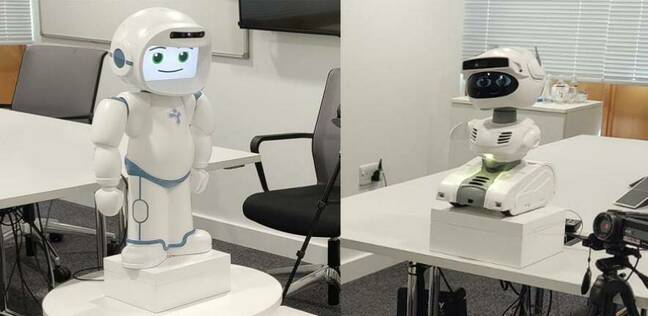Workers Don't Want These Humanoid Robots Telling Them To Be Happy
Talking robots designed to interact and help boost employees' moods at work are more effective if they don't look like humanoids, according to a British research paper.
A team of researchers from the University of Cambridge ran experiments and collected data from 26 participants communicating with two different types of robots over four weeks. The robots were programmed to behave identically and improve users' mental health by encouraging them to perform psychological exercises to help them feel more positive, optimistic, grateful, and accomplished.
But despite both robots saying exactly the same phrases and acting in exactly the same ways, the participants felt more warmly about one device than the other. It appears the biggest difference in responses was the appearance of the two robots.
The QTRobot (QT) has a pair of green eyes and a simple cartoon-drawn mouth projected onto a screen, and has a child-like plastic 90cm-tall body with human-type arms and legs. The Misty robot, on the other hand, has a screen for a face but lacks arms, has wheels instead of legs and is only 36cm high.

QTRobot on the left, Misty on the right … Image credit: Hatice Gunes.
Participants reported their interactions with Misty were more positive than QT. It seemed to be a better listener, was more caring, and behaved more naturally. They perceived the behavior of the robots to be different, even though they were identical.
"These results could be explained by the form function attribution bias," the researchers wrote in a paper [PDF] presented at the ACM/IEEE International Conference on Human-Robot Interaction> on Wednesday.
"It could be that since the Misty robot is more toy-like, it matched their expectations," Micol Spitale, first author of the study and a researcher at the University of Cambridge's Department of Computer Science and Technology, suggested in a statement. "But since QT is more humanoid, they expected it to behave like a human, which may be why participants who worked with QT were slightly underwhelmed."
- Humanoid robot takes a retail job, but not one any store clerk wants to do
- 'Robot lawyer' DoNotPay not fit for purpose, alleges complaint
- OpenAI claims GPT-4 will beat 90% of you in an exam
- Why ChatGPT should be considered a malevolent AI – and be destroyed
Users reported QT as having no personality, but reacted more positively to Misty's voice and gestures, despite their programming being exactly the same. The biggest roadblock to how effective these machines were at uplifting employees at work, however, was their communication abilities, according to Hatice Gunes, a robotics professor who led the research.
"The most common response we had from participants was that their expectations of the robot didn't match with reality. We programmed the robots with a script, but participants were hoping there would be more interactivity. It's incredibly difficult to create a robot that's capable of natural conversation. New developments in large language models could really be beneficial in this respect."
The researchers believe that more attention should be paid to the design and overall appearance of robots if developers want their devices to be useful to humans.
Minja Axelsson, a PhD student at Cambridge and a co-author of the study, concluded: "Our perceptions of how robots should look or behave might be holding back the uptake of robotics in areas where they can be useful." ®
From Chip War To Cloud War: The Next Frontier In Global Tech Competition
The global chip war, characterized by intense competition among nations and corporations for supremacy in semiconductor ... Read more
The High Stakes Of Tech Regulation: Security Risks And Market Dynamics
The influence of tech giants in the global economy continues to grow, raising crucial questions about how to balance sec... Read more
The Tyranny Of Instagram Interiors: Why It's Time To Break Free From Algorithm-Driven Aesthetics
Instagram has become a dominant force in shaping interior design trends, offering a seemingly endless stream of inspirat... Read more
The Data Crunch In AI: Strategies For Sustainability
Exploring solutions to the imminent exhaustion of internet data for AI training.As the artificial intelligence (AI) indu... Read more
Google Abandons Four-Year Effort To Remove Cookies From Chrome Browser
After four years of dedicated effort, Google has decided to abandon its plan to remove third-party cookies from its Chro... Read more
LinkedIn Embraces AI And Gamification To Drive User Engagement And Revenue
In an effort to tackle slowing revenue growth and enhance user engagement, LinkedIn is turning to artificial intelligenc... Read more

